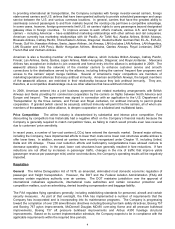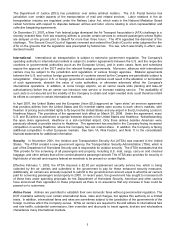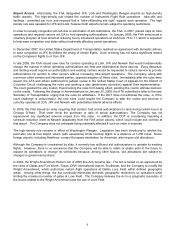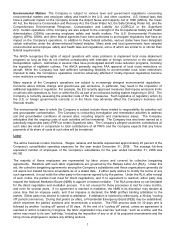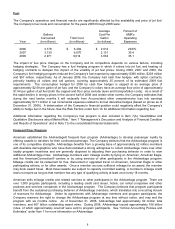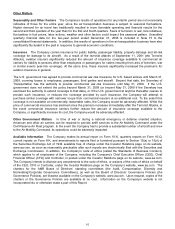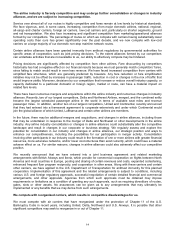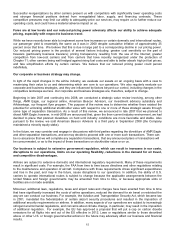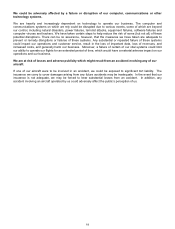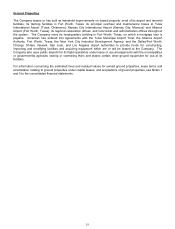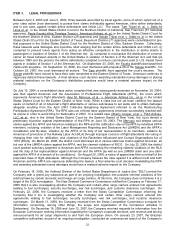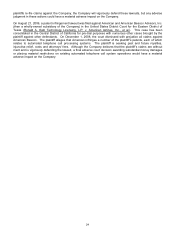American Airlines 2008 Annual Report Download - page 17
Download and view the complete annual report
Please find page 17 of the 2008 American Airlines annual report below. You can navigate through the pages in the report by either clicking on the pages listed below, or by using the keyword search tool below to find specific information within the annual report.14
The airline industry is fiercely competitive and may undergo further consolidation or changes in industry
alliances, and we are subject to increasing competition.
Service over almost all of our routes is highly competitive and fares remain at low levels by historical standards.
We face vigorous, and, in some cases, increasing, competition from major domestic airlines, national, regional,
all-cargo and charter carriers, foreign air carriers, low-cost carriers and, particularly on shorter segments, ground
and rail transportation. We also face increasing and significant competition from marketing/operational alliances
formed by our competitors. The percentage of routes on which we compete with carriers having substantially lower
operating costs than ours has grown significantly over the past decade, and we now compete with low-cost
carriers on a large majority of our domestic non-stop mainline network routes.
Certain airline alliances have been granted immunity from antitrust regulations by governmental authorities for
specific areas of cooperation, such as joint pricing decisions. To the extent alliances formed by our competitors
can undertake activities that are not available to us, our ability to effectively compete may be hindered.
Pricing decisions are significantly affected by competition from other airlines. Fare discounting by competitors
historically has had a negative effect on our financial results because we must generally match competitors’ fares,
since failing to match would result in even less revenue. We have faced increased competition from carriers with
simplified fare structures, which are generally preferred by travelers. Any fare reduction or fare simplification
initiative may not be offset by increases in passenger traffic, reduction in cost or changes in the mix of traffic that
would improve yields. Moreover, decisions by our competitors that increase or reduce overall industry capacity, or
capacity dedicated to a particular domestic or foreign region, market or route, can have a material impact on
related fare levels.
There have been numerous mergers and acquisitions within the airline industry and numerous changes in industry
alliances. Recently, two of our largest competitors, Delta and Northwest Airlines, merged, and the combined entity
became the largest scheduled passenger airline in the world in terms of available seat miles and revenue
passenger miles. In addition, another two of our largest competitors, United and Continental, recently announced
that they had entered into a framework agreement to cooperate extensively and under which Continental would
join the global alliance of which United, Lufthansa and certain other airlines are members.
In the future, there may be additional mergers and acquisitions, and changes in airline alliances, including those
that may be undertaken in response to the merger of Delta and Northwest or other developments in the airline
industry. Any airline industry consolidation or changes in airline alliances could substantially alter the competitive
landscape and result in changes in our corporate or business strategy. We regularly assess and explore the
potential for consolidation in our industry and changes in airline alliances, our strategic position and ways to
enhance our competitiveness, including the possibilities for our participation in merger activity. Consolidation
involving other participants in our industry could result in the formation of one or more airlines with greater financial
resources, more extensive networks, and/or lower cost structures than exist currently, which could have a material
adverse effect on us. For similar reasons, changes in airline alliances could also adversely affect our competitive
position.
We recently announced that we have entered into a joint business agreement and related marketing
arrangements with British Airways and Iberia, which provide for commercial cooperation on flights between North
America and most countries in Europe, pooling and sharing of certain revenues and costs, expanded codesharing,
enhanced frequent flyer program reciprocity, and cooperation in other areas. Along with these carriers and certain
other carriers, we have applied to the U.S. Department of Transportation for antitrust immunity for this planned
cooperation. Implementation of this agreement and the related arrangements is subject to conditions, including
various U.S. and foreign regulatory approvals, successful negotiation of certain detailed financial and commercial
arrangements, and other approvals. Agencies from which such approvals must be obtained may impose
requirements or limitations as a condition of granting any such approvals, such as requiring divestiture of routes,
gates, slots or other assets. No assurances can be given as to any arrangements that may ultimately be
implemented or any benefits that we may derive from such arrangements.
We compete with reorganized carriers, which results in competitive disadvantages for us.
We must compete with air carriers that have reorganized under the protection of Chapter 11 of the U.S.
Bankruptcy Code in recent years, including United, Delta, Northwest and U.S. Airways. It is possible that other
significant competitors may seek to reorganize in or out of Chapter 11.


